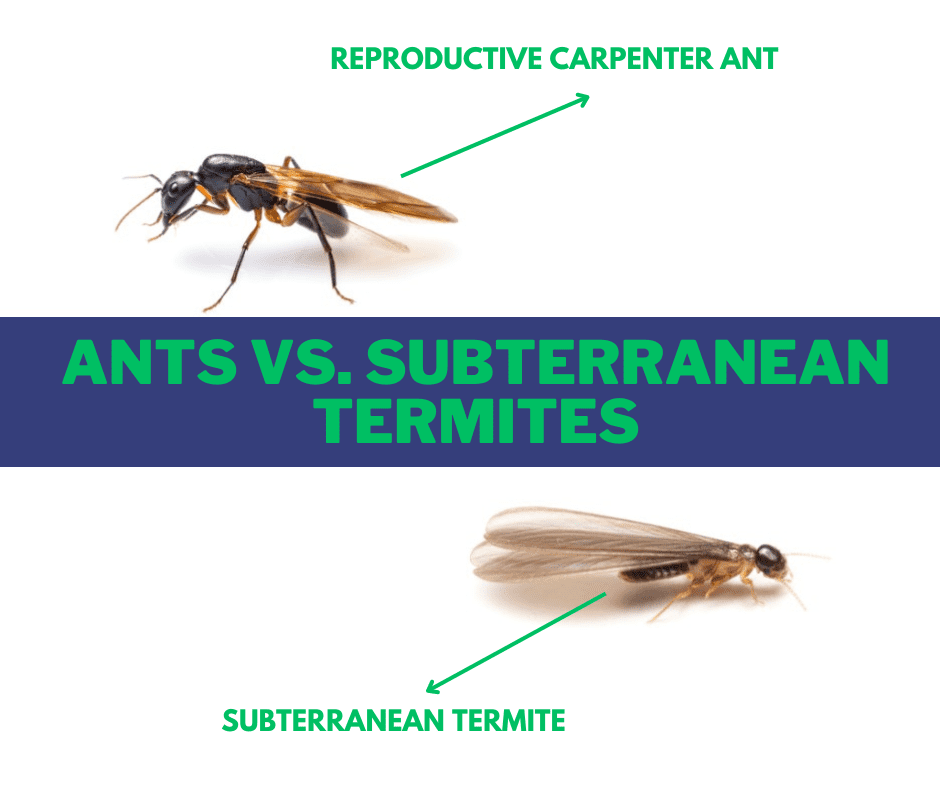As the blankets of snow recede and the early bloomers start to sprout, our hearts aren’t the only ones filled with the joy of spring. This season also heralds the return of some of nature’s smallest yet most industrious creatures: ants and subterranean termites. While both play crucial roles in our ecosystem, when it comes to our homes, they can be less than welcome guests. Knowing how to tell them apart is the first step in ensuring your springtime bliss isn’t dampened by unexpected home invaders.

Ants vs. Subterranean Termites: Know the Difference This Spring
As the blankets of snow recede and the early bloomers start to sprout, our hearts aren’t the only ones filled with the joy of spring. This season also heralds the return of some of nature’s smallest yet most industrious creatures: ants and subterranean termites. While both play crucial roles in our ecosystem, when it comes to our homes, they can be less than welcome guests. Knowing how to tell them apart is the first step in ensuring your springtime bliss isn’t dampened by unexpected home invaders.
The Battle Underfoot: Ants
Ants are social insects, forming complex colonies that can sprawl across your garden and into your home if you’re not vigilant. They come in search of food and, inadvertently, can lead you to discover other issues in your home, like leaks or hidden sweets. However, not all ants are created equal. The carpenter ant, in particular, can cause confusion due to its destructive wood-burrowing habits, which are often mistaken for termite damage.
Identifying Features of Ants:
- Body Shape: Ants have a distinct, pinched waist, three body segments, and bent antennae.
- Size and Color: They vary widely, from tiny black pavement ants to the larger, reddish-brown carpenter ants.
- Behavior: Ants are often seen in the open, foraging in long lines and are more interested in your picnic than your pantry.
The Underground Menace: Subterranean Termites
Subterranean termites, on the other hand, are a homeowner’s nightmare. These termites live in underground colonies and can infiltrate your home from below, feasting on the wood that forms the structure of your property. They’re less about the food in your kitchen and more about the very walls around you.
Identifying Features of Subterranean Termites:
- Body Shape: Termites have a more rectangular body shape without a distinct waist and straight antennae.
- Size and Color: Generally, they are about the same size or slightly larger than ants but are often a translucent white, beige, or light brown.
- Behavior: Subterranean termites are elusive, often hidden away in wood or beneath the soil, making them harder to detect until significant damage is done.
Spot the Difference: Winged Ants vs. Termites
Spring is not just a time for blooming flowers; it’s also when many ant and termite species take flight. Both ants and termites can produce winged reproductives, known as alates, which swarm out to start new colonies. This is when most homeowners notice them and when confusion is most likely to occur.
Here’s how to tell them apart:
- Wings: While both have two pairs, ant wings are different in size with the front pair being larger. Termite wings are equal in size and shape.
- Waist: Winged ants maintain that characteristic pinched waist, whereas termites do not.
- Antennae: Ants have bent antennae, while termites’ antennae are straight.
Prevention and Control
For Ants:
- Keep food sealed and crumbs cleaned up.
- Seal up cracks and entry points around your home.
- Consider natural deterrents or professional pest control if the problem persists.
For Termites:
- Regularly inspect your home for signs of damage and mud tubes.
- Eliminate wood-to-ground contact around your home.
- Consult with a pest control professional for inspection and treatment options.
Final Thoughts
While both ants and subterranean termites signify the vibrant ecosystem at work in your backyard, knowing how to tell them apart and manage their presence can save you from potential headaches. By staying vigilant and adopting preventive measures, you can enjoy the spring without worrying about these unwelcome guests.
Springtime should be about new beginnings, not about dealing with old pests. With this guide in hand, you’re now equipped to tell the difference between ants and those pesky subterranean termites, ensuring your home remains a sanctuary for you, not them. Remember, when in doubt, calling in the professionals is always a safe bet to keep your springtime serene and secure.
Do you have any other tips or experiences in dealing with ants and termites as the weather warms up? Share them in the comments below!
Here’s an interesting read on natural pest control methods that might give you some additional insights and strategies to keep your home pest-free this spring.
FAQs:
-
How can I tell if I have termites or ants? Look for physical differences such as body shape, waist, and antennae. Ants have a pinched waist and bent antennae, while termites have a straight waist and straight antennae.
-
Are termites more dangerous to my home than ants? Yes, termites can cause significant structural damage to your home because they feed on wood, whereas ants are more of a nuisance unless you’re dealing with carpenter ants, which can also damage wood.
-
What should I do if I find termites in my home? Contact a professional pest control service immediately. Termites can cause extensive damage, and early detection and treatment are crucial.
-
Can I handle an ant infestation on my own? Many ant infestations can be managed with diligent cleaning, sealing entry points, and using ant baits. However, for persistent or large infestations, professional help might be necessary.
Springtime should be about new beginnings, not about dealing with old pests. With this guide in hand, you’re now equipped to tell the difference between ants and those pesky subterranean termites, ensuring your home remains a sanctuary for you, not them. However, recognizing a problem is only the first step. When it comes to effectively addressing an ant or termite infestation, professional intervention is often necessary.
That’s where STL Pest Control comes into play. Why choose us for your pest control needs? Here are a few reasons:
-
Expertise and Experience: At STL Pest Control, we’re not just pest control technicians; we’re experts who understand the unique behaviors and weaknesses of ants, termites, and other household pests. This means we can provide targeted, effective treatments that get to the root of the problem.
-
Safety First: We prioritize your family’s safety and the well-being of your pets. Our treatment methods are designed to be as non-invasive and environmentally friendly as possible, ensuring a safe home environment for everyone.
-
Long-term Solutions: We don’t just aim to fix the problem at hand; we strive to prevent future infestations. Our team will provide you with the knowledge and tools to keep pests at bay, offering peace of mind that your home is protected year-round.
-
Local Knowledge: As a local business, STL Pest Control understands the specific pest challenges faced by residents in our area. We’re familiar with the local species of ants and termites, which allows us to tailor our approach for maximum effectiveness.
Remember, when in doubt, calling in the professionals is always a safe bet to keep your springtime serene and secure. With STL Pest Control, you’re not just hiring a pest control service; you’re partnering with a team dedicated to making your home a better, pest-free environment.
Contact STL Pest Control today and let us take the worry out of your springtime pest management. Let this season be the one where you finally take back control of your home from unwelcome invaders.

